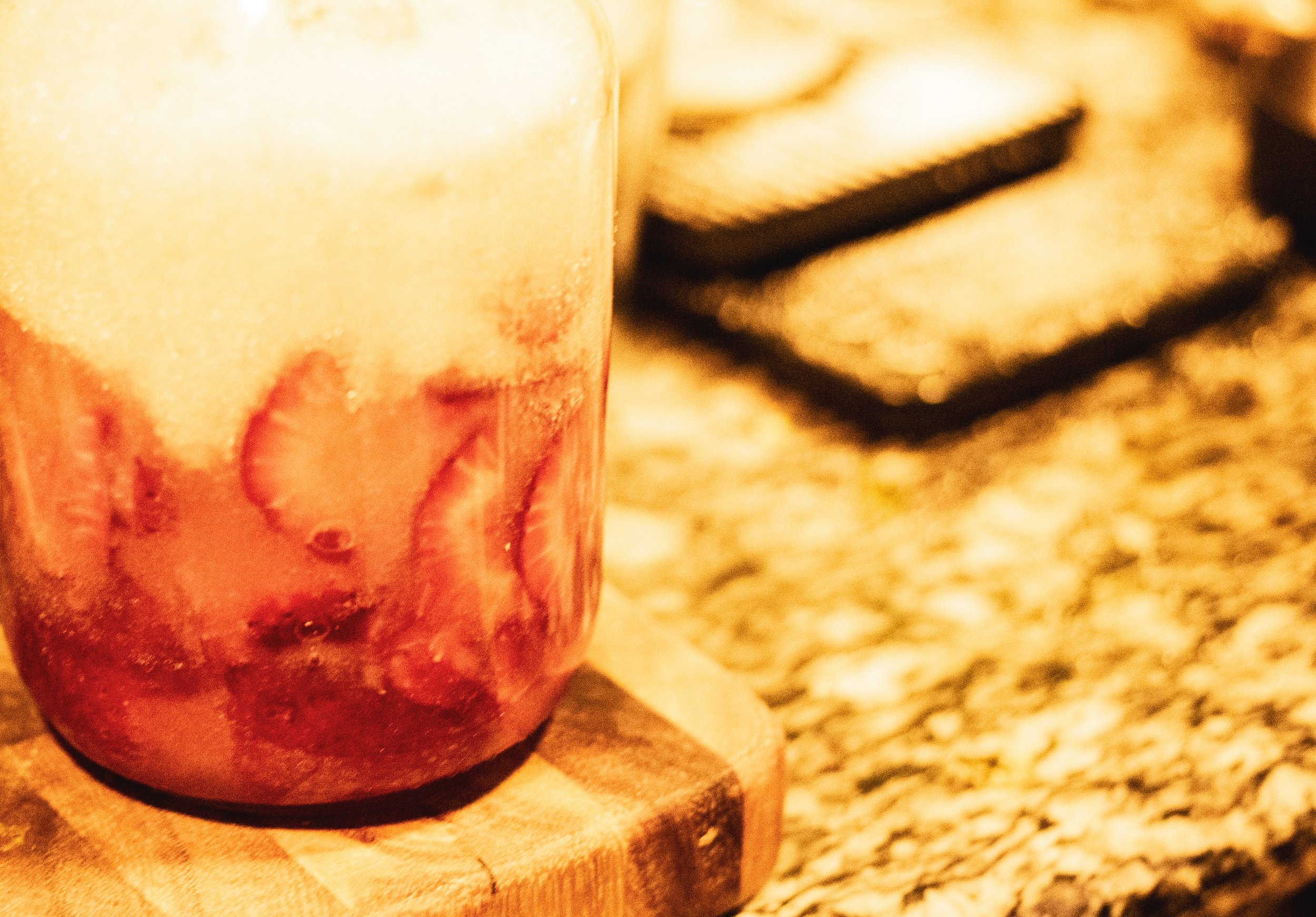Yes Whey! A Beginner's Fermentation Guide to a Healthy and Delicious Pancake Breakfast
By this point, you are likely familiar with fermented foods. The concept is simple - beneficial organisms are grown on food to enhance flavor, increase nutritional value, and enhance health outcomes. This ancient technique for food preservation takes on many forms but lactofermenation is in focus as the main driver in health benefits. While fermented foods are all over your supermarket shelves these days, I invite you to step up your game and begin to ferment foods for yourself! Here is a beginner-level recipe to make a healthy-ish pancake breakfast that is packed with the health benefits of fermentation.
The recipe involves preparatory steps at least 12 and up to 48 hours before you eat your breakfast so make sure you have the time you need! The grains in the pancake batter and berries for the berry sauce are fermented with whey, while additional berries are macerated in sugar and lightly fermented in a cheong, a traditional Korean syrup.
This recipe uses yogurt-derived whey (acid whey) as its starter culture. Acid whey is the protein rich liquid that pools on the top of your yogurt. Using this as a starter is more fool proof than relying on the natural cultures that are present on foods (if you are interested in that route, keep an eye out for future recipes!).
More on Health
Lactofermentation is a natural preservation process where beneficial bacteria, primarily Lactobacillus, convert sugars in food (like vegetables or dairy) into lactic acid. This creates an acidic environment that preserves the food, enhances its flavor with tangy notes, and promotes gut-healthy probiotics. Common examples include sauerkraut, kimchi, and yogurt.
Interestingly, both living (probiotic) and dead (parabiotic) cultures have positive health effects. Live cultures colonize the intestinal mucosa, which can modulate immune response, reducing the severity of autoimmune aggressions and lowering allergic response [1,3]. Dead cells stimulate the intestinal lining and promote healthy signaling pathways - one could think of it as mental health for the gut brain[2]!
Fermentation can also enhance the nutritional value of foods even after they are cooked. Fermented nuts have been shown to have higher antioxidant power and more easily absorbed polyphenols, which help improve health by lowering the risk of chronic diseases and cardiovascular issues [4}.
Fermented Blackberry Sauce
INGREDIENTS
- For the Fermented Blackberries
- 1 Cup blackberries
- 2 Tbsp acid whey w/ active cultures (from your yogurt)
- 1/4 tsp salt
- For the Blackberry Cheong
- 16 Oz blackberries (~3 Cups)
- 16 Oz white Sugar (2 1/4 Cups)
NOTE: Any sufficiently juicy fruit will work for this recipe.
INSTRUCTIONS
- Harvest your whey from your yogurt by spooning it off of the top of your container or by straining through a bowl lined with cheese cloth or paper towels.
- In a mason jar or conatiner with a screwable lid, combine the salt, blackberries, and whey. Close the lid and shake gently. Unscrew the lid a small amount until it is very slightly loose. Leave at room temperature away from direct light overnight or up to 48 hours.
- To make the cheong, in a wide jar or tall container, combine the blackberries and the sugar. Stir or shake to cover all of the berries. Leave overnight at room temperature away from direct light for up to a week.
- To make the sauce, simply combine the cheong and the fermented berries. You can serve the blackberries whole along with the syrup or strain through a fine mesh sieve for a thicker sauce.




Fermented Pancakes
INGREDIENTS
- 1 Cup hazelnut or other nut flour
- 3/4 Cup all purpose flour
- 3/4 Cup whole wheat flour.
- 2 Tbsp acid whey w/ active cultures (from your yogurt)
- 1/2 tsp salt
- 2 Cups water
- 2 eggs
- 2 Tbsp butter, melted
- 1 tsp baking powder
INSTRUCTIONS
- Harvest your whey from your yogurt by spooning it off of the top of your container or by straining through a bowl lined with cheese cloth or paper towels.
- In a bowl or large tupperware, combine the flours, the salt, the water, and the whey. Stir to combine. Cover with plastic wrap or your container top. Leave at room temperature away from direct light overnight or up to 48 hours.
- To finish the batter, mix in the melted butter, eggs, and baking powder. Add more water to your desired consistency.
- Heat a pan over medium heat. Add butter or oil to the pan. Add the batter and cook on one side until bubbles near the middle of the pancake open and don't close. Flip. Serve. Enjoy.


Reminder:
YOU are the final arbiter of your tasting experience. If you don’t like something, take note and adjust what you dislike or remove it from future applications. don’t be bound to tradition. take recipes with a grain of salt and make them yours!
References
Bao, Y.; Wang, Z.; Zhang, Y.; Zhang, J.; Wang, L.; Dong, X.; Su, F.; Yao, G.; Wang, S.; Zhang, H. Effect of Lactobacillus plantarum P-8 on lipid metabolism in hyperlipidemic rat model. Eur. J. Lipid Sci. Technol. 2012, 114, 1230–1236.
Conte, M.; Porpora, M.; Nigro, F.; Nigro, R.; Budelli, A.L.; Barone, M.V.; Nanayakkara, M. Pro-Pre and Postbiotic in Celiac Disease. Appl. Sci. 2021, 11, 8185.
Sugawara, T.; Sawada, D.; Ishida, Y.; Aihara, K.; Aoki, Y.; Takehara, I.; Takano, K.; Fujiwara, S. Regulatory effect of paraprobiotic Lactobacillus gasseri CP2305 on gut environment and function. Microb. Ecol. Health Dis. 2016, 27, 30259.
Tabanelli G, Montanari C, Gómez-Caravaca AM, Díaz-de-Cerio E, Verardo V, Zadeh FS, Vannini L, Gardini F, Barbieri F. Microbiological Safety and Functional Properties of a Fermented Nut-Based Product. Foods. 2024 Sep 27;13(19):3095. doi: 10.3390/foods13193095. PMID: 39410129; PMCID: PMC11475193.


